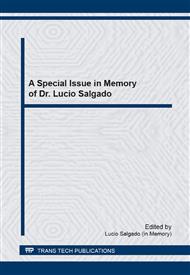p.128
p.137
p.143
p.149
p.155
p.161
p.167
p.172
p.178
Anodic Protection of Carbon Steel AISI 1006 Using the Binder of Undoped Polyaniline
Abstract:
The use of intrinsically conductive polymers such as polyaniline (PAni) has been presented as an alternative protective coating against corrosion, it intensifies the effect of anodic passivation and protection of the material. Given the difficulty in obtaining films of polyaniline in the oxidized form and driver in a self-supported and cohesive on the surface of metal substrates. Was held the undoped of the polymer, with the use of NH4OH solution to passing the PAni oxidized state and non-conducting polyaniline emeraldine base known as PAni EB. The complete mixture of PAni EB, organic solvent and plasticizer 4-chloro-3-methylphenol, allowed to obtain a resin. This was applied in AISI 1006 steel plates with the aid equipment Spin Coater. The film was characterized by thermal analysis TGA, where it was found that the coating is the result of the reaction components, predominantly the structure of PAni EB. The electrochemical tests of Cyclic Voltammetry and Potential Open Circuit were carried out in 2 molL-1 H2SO4 solution, which indicated the formation of redox couple polymer-metal, which provides the formation of passivating oxides, which allow the metal anodic protection against corrosion.
Info:
Periodical:
Pages:
155-160
Citation:
Online since:
September 2014
Price:
Сopyright:
© 2015 Trans Tech Publications Ltd. All Rights Reserved
Share:
Citation:


